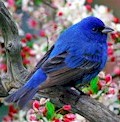Autumn approaches. It is back-to-school season, harvest season, foliage-watching season, and, of course, football season. As many of you know, it is also migrating season for many birds. Soon, many of our winged friends will be wind-bound to warmer climes. It is a very important time of year for birds, and there are some things that backyard birders can do to help them. (I should note that every time of year is very important for birds; fall simply has its own set of challenges and opportunities.)
Beginning in the late summer into fall, long-distance migrants begin to exhibit communal roosting behavior. Purple martins, having recently fledged their young, gather in large groups in preparation for their long trip to South America. They abandon the purple martin birdhouses that were lovingly tended over by caring landlords for the past several months. Purple martins only eat insects, which they catch on the wing, often displaying an amazing aerial mastery in the act, so providing food is usually not an issue. They do need a source of fresh water, however. Purple martins usually make use of lakes, rivers, or streams, but a birdbath or other garden water features will do in a pinch. This is true of many birds that gather in such a way before migrating. Adding a mister or dripper will greatly increase traffic to birdbaths.
Short to medium-distance migrants are often fruit or seed eaters (at least part of the time), so providing a feeder can be a great way to help them build up their energy in the pre-migratory days of fall. Even the beautiful Indigo Bunting will occasionally visit bird feeders to supplement its diet before it heads off to Mexico, the Caribbean, and points south.
There is an important point here that must not be overlooked. Many people still believe that feeding wild birds in autumn will keep them here too long. The thinking is that with a plentiful supply of food, these birds will not realize that the harsh winter is on its way. However, the avian world does not work that way. Birds are creatures of instinct, and the timing and routes of migration are followed regardless of the actions of backyard birders. In fact, because migratory birds need to increase their energy stores before setting off on their trip, taking down a bird feeder in fall could cause the birds some difficulty.
Now that we know that feeders are helpful to birds in autumn, we should discuss some bird feeder basics. This first, very important point cannot be overstated: bird feeders must be kept clean! Mold and parasites will begin to grow in the bird feeder, and that is really bad for the birds. On a regular basis, empty the feeder and clean it inside and out with water and a mild detergent. Do not use bleach. Rinse the bird feeder thoroughly, and allow it to dry completely. Then, just refill and replace. Twice a month is a good rule of thumb, but if you live in a humid climate, you should clean it even more often.
The other facet of proper bird feeder management is placement. Let me give you an example that will illustrate exactly what not to do. Recently, I took a walk in my neighborhood, and I saw a bird feeder hanging from a tree. It was a kitschy feeder in the shape of a lighthouse. Usually, these lighthouse things are birdhouses, not bird feeders, but this one was definitely a 4-port feeder. It was hanging no more than three inches above a shrub with some tall grasses around it. If this opaque feeder managed to attract any birds at all, it would be a surprise. Birds have very acute sight, and they find food by spotting it visually. Not to mention that, with all the hiding places for predators around, the feeder may be more accurately described as a cat feeder. I am sure that the owners of this particular bird feeder were well meaning, but, honestly, inside a garbage can would have been better placement.
Ideally, backyard birders should put feeders in an area that is at least fifteen feet away from shrubs, hedges, and tall grasses. It should be fairly close to a tree or other place where birds may perch and look for food, which they will find in your feeder, of course.
Give each of your bird feeders a thorough inspection a couple of times a year. Cracks and chips in the casing are a potential reservoir for bacteria and other nasty stuff. Make sure the grommets around feeder ports are tight. Check the mechanical or moving parts on squirrel-resistant feeders. They should be clean, rust-free, and they should move smoothly and easily.
Autumn is a great time for backyard birders. Keep your birdbaths and bird feeders clean and ready, and see how many different birds stop by. Get the whole family involved; it is an educational quality time that can bring people together. Enjoy each other, enjoy life, and enjoy the birds!
